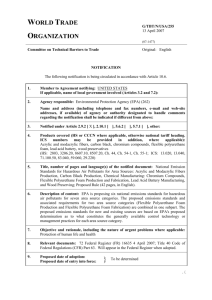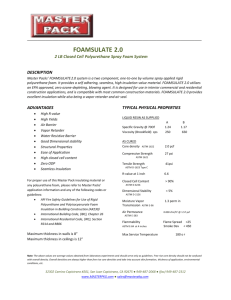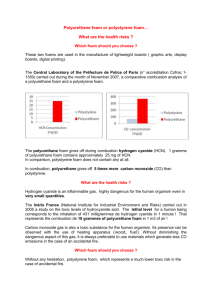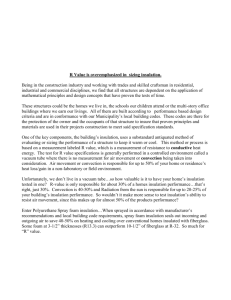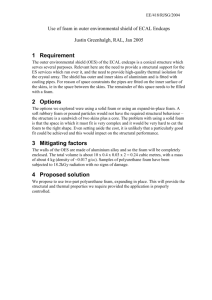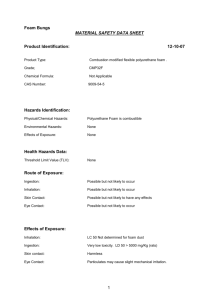62 SHORE D POLYUREA SPRAY ELASTOMER
advertisement
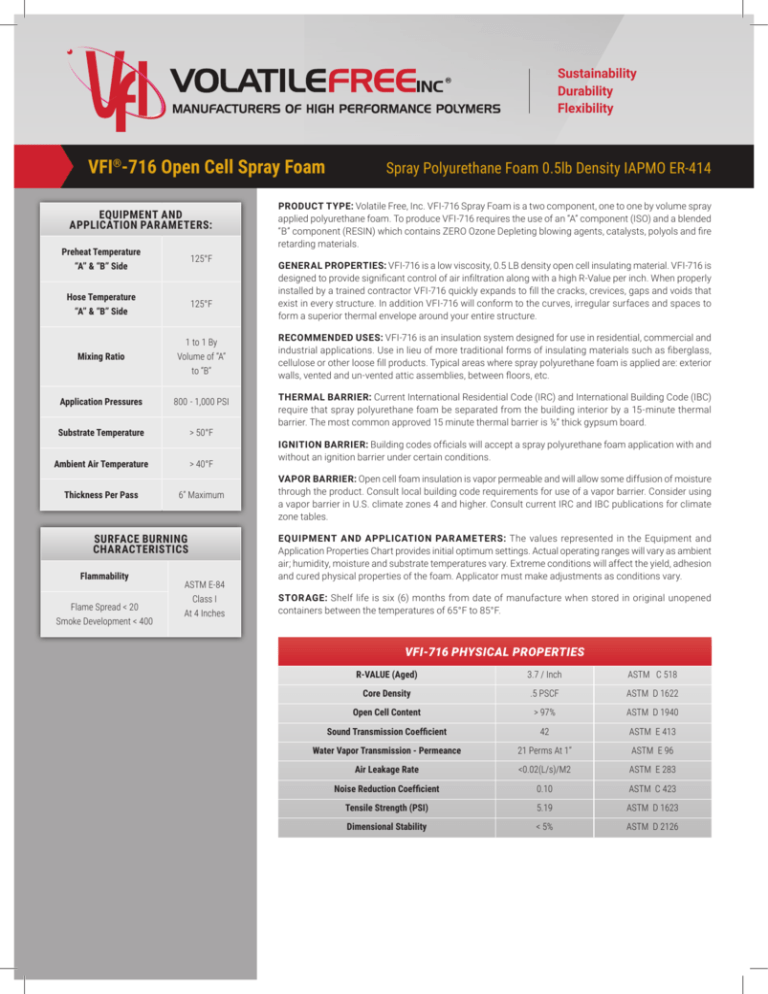
Sustainability Durability Flexibility VFI®-716 Open Cell Spray Foam EQUIPMENT AND APPLICATION PARAMETERS: Spray Polyurethane Foam 0.5lb Density IAPMO ER-414 PRODUCT TYPE: Volatile Free, Inc. VFI-716 Spray Foam is a two component, one to one by volume spray applied polyurethane foam. To produce VFI-716 requires the use of an “A” component (ISO) and a blended “B” component (RESIN) which contains ZERO Ozone Depleting blowing agents, catalysts, polyols and fire retarding materials. Preheat Temperature “A” & “B” Side 125°F Hose Temperature “A” & “B” Side 125°F Mixing Ratio 1 to 1 By Volume of “A” to “B” RECOMMENDED USES: VFI-716 is an insulation system designed for use in residential, commercial and industrial applications. Use in lieu of more traditional forms of insulating materials such as fiberglass, cellulose or other loose fill products. Typical areas where spray polyurethane foam is applied are: exterior walls, vented and un-vented attic assemblies, between floors, etc. Application Pressures 800 - 1,000 PSI Substrate Temperature > 50°F THERMAL BARRIER: Current International Residential Code (IRC) and International Building Code (IBC) require that spray polyurethane foam be separated from the building interior by a 15-minute thermal barrier. The most common approved 15 minute thermal barrier is ½” thick gypsum board. Ambient Air Temperature > 40°F Thickness Per Pass 6” Maximum SURFACE BURNING CHARACTERISTICS Flammability Flame Spread < 20 Smoke Development < 400 ASTM E-84 Class I At 4 Inches GENERAL PROPERTIES: VFI-716 is a low viscosity, 0.5 LB density open cell insulating material. VFI-716 is designed to provide significant control of air infiltration along with a high R-Value per inch. When properly installed by a trained contractor VFI-716 quickly expands to fill the cracks, crevices, gaps and voids that exist in every structure. In addition VFI-716 will conform to the curves, irregular surfaces and spaces to form a superior thermal envelope around your entire structure. IGNITION BARRIER: Building codes officials will accept a spray polyurethane foam application with and without an ignition barrier under certain conditions. VAPOR BARRIER: Open cell foam insulation is vapor permeable and will allow some diffusion of moisture through the product. Consult local building code requirements for use of a vapor barrier. Consider using a vapor barrier in U.S. climate zones 4 and higher. Consult current IRC and IBC publications for climate zone tables. EQUIPMENT AND APPLICATION PAR AMETERS: The values represented in the Equipment and Application Properties Chart provides initial optimum settings. Actual operating ranges will vary as ambient air; humidity, moisture and substrate temperatures vary. Extreme conditions will affect the yield, adhesion and cured physical properties of the foam. Applicator must make adjustments as conditions vary. STORAGE: Shelf life is six (6) months from date of manufacture when stored in original unopened containers between the temperatures of 65°F to 85°F. VFI-716 PHYSICAL PROPERTIES R-VALUE (Aged) 3.7 / Inch ASTM C 518 Core Density .5 PSCF ASTM D 1622 Open Cell Content > 97% ASTM D 1940 Sound Transmission Coefficient 42 ASTM E 413 Water Vapor Transmission - Permeance 21 Perms At 1” ASTM E 96 Air Leakage Rate <0.02(L/s)/M2 ASTM E 283 Noise Reduction Coefficient 0.10 ASTM C 423 Tensile Strength (PSI) 5.19 ASTM D 1623 Dimensional Stability < 5% ASTM D 2126 Sustainability Durability Flexibility VFI®-716 Open Cell Spray Foam Spray Polyurethane Foam 0.5lb Density IAPMO ER-414 General Information Application Guidelines Finished Foam Protection VFI-716 is suitable for application to most construction materials including wood, masonry, concrete, and metal. All surfaces to be sprayed with foam should be clean, dry, and free of dew or frost. All metal to which the foam is to be applied must be free of oil, grease, etc. Six (6) inches should be the maximum thickness of each pass. Allow ten minutes between each pass to allow for cooling. Multiple layers can be applied to reach the desired thickness and R-Value. The finished surface of the sprayed polyurethane foam should be protected from the adverse effects of direct exposure of ultraviolet light from the sun. This exposure will cause dusting and discoloration. Protective coatings designed for use with polyurethane foams are available from Volatile Free, Inc. Substrate temperature at the time of the VFI-716 application should be between 50°F to 120°F, the warmer the surface, the better the adhesion. For temperatures outside of this range you must consult the Technical Services department prior to application. When removing bungs from containers use caution, contents may be under pressure. Loosen the small bung first and let any built up gas escape before completely removing. The resin “B” component will froth at elevated temperatures. Avoid prolonged breathing of vapors. In case of chemical contact with eyes, flush with water for at least 15 minutes and get medical attention. For further information refer to “MDI-Based Polyurethane Foam Systems: Guidelines for Safe Handling and Disposal” publication AX-119 published by the Alliance For The Polyurethanes Industry, Arlington, VA. As with all spray polyurethane foam systems, improper application techniques should be avoided. Examples of improper techniques include, but are not limited to, excessive thickness of spray polyurethane foam, off ratio material and spraying into or under rising foam. Potential results of improperly installed spray polyurethane foam include: dangerously high reaction temperatures that may result in fire and offensive odors that may or may not dissipate. Improperly installed foam must be removed and replaced with properly installed spray polyurethane foam. It is the responsibility of the applicator to thoroughly understand all equipment technical information and safe operating procedures that pertain to a spray polyurethane foam application. When changing the “B” side (resin) to another type of spray polyurethane foam it is very important that the supply hoses and pumps are completely drained. Mixing of dissimilar product types will have an adverse effect on the foam. Spray polyurethane foam insulation is combustible. High intensity heat sources such as welding or cutting torches must not be used in close proximity to any polyurethane foam. Large masses of spray polyurethane foam should be removed to an outside safe area, cut into smaller pieces, and allowed to cool before discarding into a trash receptacle. Equipment and Component Ratios Polyurethane foam systems should be processed through commercially available spray equipment designed for that purpose. VFI-716 “A” side is connected to the isocyanate pump and the VFI-716 “B” side is connected to the resin pump. The proportioning pump ratio is 1 to 1 by volume. The pre-heater initial setting should be 125°F. The initial hose temperature should be 125°F. Equipment must be capable of maintaining temperature settings. Safe Handling of Liquid Components Health and Safety Due to the reactive nature of these components respiratory protection is mandatory. The vapors and liquid aerosols present during application and for a short period thereafter must be considered – and appropriate protective measures taken – to minimize potential risks from overexposure through inhalation, skin, or eye contact. These protective measures include: adequate ventilation, safety training for installers and other workers, use of appropriate personal protective equipment, and a medical surveillance program. It is imperative that the applicator read and become familiar with all available information on proper use and handling of spray polyurethane foam. Additional information is available by contacting the technical services department of Volatile Free, Inc. Storage and Use of Chemicals Cold chemicals can cause poor mixing, pump cavitations, or other process problems due to higher viscosity at lower temperatures. Storage temperatures should be 65°F to 85°F for several days before use, and should not exceed 90°F. Do not store in direct sunlight. Keep drums tightly closed when not in use and under dry air or nitrogen pressure of 2-3 psi after they have been opened. Shelf life is six (6) months from date of manufacture when stored in original unopened containers at 65°F to 85°F. Store in a dry and well-ventilated area. Setting the standard for Renewable Coatings and Spray Foams For more information, contact us today at 800-307-9218 Check out our website at www.volatilefree.com This information and technical advice provided herein are believed to be reliable and accurate to the best knowledge of Volatile Free, Inc., As based on tests and should serve only as a recommendation. As the manufacturer, Volatile Free, Inc makes no representations or warranties of any kind, expressed, implied or statutory, including but not limited to all implied warranties of merchantability or fitness for use or a particular purpose, or any other matter with respect to this product. Volatile Free, Inc makes no representations or warranties as to the results of the use of the product and assumes no obligation or liability in connection therewith. Volatile Free, Inc is not liable for any special, exemplary, punitive, incidental or consequential damages of any sort or kind from use of this product. The information provided herein is subject to change at any time without notice. Information changes may include, but are not limited to, commercial and technical changes, changes in pricing, physical characteristics and packaging.


